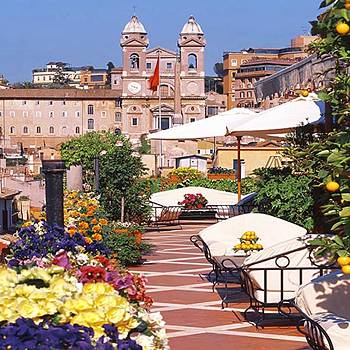



By Hoda Nassef
After recently being honoured in Italy by the Italian Ambassador to Egypt, Antonio Badini, on the 25th of June 2007 Dr. Abdel- Moneim Kamel, Artistic Director of the Cairo Opera House, was among the few to be awarded the Mubarak Prize for Arts.
Dr. Abdel-Moneim Kamel, was appointed as Artistic Counsellor of the Chairman of the National Cultural Centre of Cairo and The Artistic Director for Music, Opera & Ballet Sector in 1998, up till the present date. I looked forward to meeting man who literally resurrected the Cairo Opera Ballet troupe over twenty years ago, after the original Cairo Opera House burnt down, the Russian ballet instructors had left, and the major cultural scene had become almost extinct. Most of all, I wondered how he did it, how he expanded and perfected the Cairo Ballet Troupe and transformed it into the leading ballet company of Egypt and the Middle East, equal to one of the best in the world.
I have seen him often enough on stage, and lately sometimes on television, while either bowing to the applause during ‘curtains’ and ‘encores’ for his Ballet Troupe, or as a TV presenter for live or televised ballet performances. I expected to meet a typical extrovert, but was amazed when I met this rather reserved and shy, yet extremely handsome middle-aged man who appeared to be (touch wood) not a day older than 35. Born in Cairo on February 21, 1949, Kamel graduated from the Cairo Academy of Art, Higher Institute of Ballet, in 1967, then obtained his M.A. specialising in ballet in 1969 from the same Academy, as well as a master’s degree in 1969 from the Faculty of Commerce, Cairo University. He later achieved his Ph.D. in ballet from a university in Moscow in 1979. In 1991 till 1992, he was appointed as Director for Dance at the Higher Institute of Ballet (Academy of Art). He is a Board Member of the National Cultural Association since1998 up till the present, and speaks fluently English, French, Italian, and Russian, apart from his native Arabic.
Kamel graduated high school in 1965. His primary schools were at “Nokrashy El Namuzigaya School”, when he first lived in Heliopolis, then after the 1956 War, the family moved to Garden City, and he went to “El Caumaya School” in El-Manial (the National School) which had two branches, one in Heliopolis, and the other in Manial.
ACHIEVING HIS PH.D:
His father, explained Kamel, who was the Dean of the Faculty of Engineering, then late became the Vice President of Ein Shams University prior to his retirement, had insisted on Kamel achieving a university degree as well, so when Kamel was twenty, he graduated from the Faculty of Economy & Commerce in 1969 and graduated during the same year from the Institute of Higher Ballet. Before graduation, both he and his colleague, now world-famous pianist Dr. Ramzy Yassa, received a “closed scholarship” (selective scholarship) to Russia, in their respective fields, from the Institute of Higher Ballet (now named The Academy of Art). Immediately after graduation, they both continued their studies in Russia. Kamel left for Russian in September 1969, and earned his Ph.D. in 1979.
He achieved his M.A. in choreography (directing ballet) much earlier, and as to my query of what took him so long for his doctorate, he replied somewhat shyly, “When I first left for Russia, the ballet institute had recently been founded, and I did not want to lose my place as the first dancer and performer in Egypt. Therefore, I came back to Egypt, performed during the seasons for about three months, and then returned to Russia. This went on for several years, and I don’t regret the delay. Otherwise, I would not have achieved the acclaim and experience I had acquired.” He explained further that since he was only twenty, it would be better to have more dancing experience before acquiring a Ph.D., and his professors also agreed to this, and even advised him not to hurry. While most dancers achieve a Ph.D. at 35 or 38, their professional dancing careers have come to an end, whereas his was only beginning.
FIRST STEPS:
At the age of eighteen, he started his career as a principal dancer in several classical ballets, trained by Russian experts. His roles included ‘Albert’ in “Giselle”, ‘Don Basil’ in “Don Quixote”, the ‘Prince’ in “Sheherazade, ‘Sigfried’ in “Swan Lake”, “Hamlet”, the ‘Prince’ in “The Fountain of Bakchisaray”. He also danced as a guest artist in famous international theatres, such as in the Bolshoï Theatre, the Kirov Theatre, the New Siberia Theatre, the Sofia Theatre, the N.H.K. Theatre in Tokyo, as well as in the National Theatre of Maracaibo, and was engaged for two years at the La Scala Theatre of Milan as a Soloist, where incidentally he met his lovely Italian wife, Erminia Gambarelli.
It is noteworthy to mention that the Cairo Opera Ballet Troupe was established in 1966, affiliated to the Higher Institute of Ballet (Academy of Art), and the dance instructors were all Russian experts. Before the beautiful old Opera House was burnt down (identical to the one in Italy, and built by the same architect) the first ballet production was “The Fountain of Bakchisaray” directed by Leonied Labrovsky (who was a former director of the Bolshoï Theatre). Its repertoire later included performances of other great classical ballets, as “Swan Lake”, “Giselle”, “Pakhita”, “The Nutcracker”, and others.
Before the beautiful old Opera House was burnt down (identical to the one in Italy, and built by the same architect) and since 1973, the Cairo Opera Ballet Troupe has presented its works outside Egypt, with its first shows in Moscow, Leningrad, Bulgaria, Yugoslavia, Germany, France and Tunis. In recent years, however, they have performed extensively abroad, such as in Italy, France (again) Germany, Korea, Japan, Mexico, Tunis, Bulgaria, England, USA, China and lately the Czech Republic.
STAR SOLOIST ABROAD:
As a visiting First Dancer abroad, the following are included in his repertoire:
- Visiting Dancer at the Bolshoï Theatre in Moscow, Soviet Union (then, Russia.)
- Visiting Dancer at the Kirov St. Petersburg Theatre, Russia.
- Visiting Dancer at the Bolshoï Tushkanda Theatre, Soviet-Uzbekistan.
- Visiting Dancer at the Novo Sirsik Theatre, in Russia.
- Visiting Dancer at the Sofia Theatre, in Sophia, Bulgaria.
- Visiting Dancer at the Belgrade Theatre, Yugoslavia.
- Visiting Dancer at the N.H.K. Tokyo Theatre, Japan.
- Visiting Dancer and Ballet Instructor at the Bolshoï Theatre, Moscow, for 18 months in 1978.
- Visiting Dancer & Soloist in two ballet theatres in Caracas.
- Visiting Dancer & Soloist for two years (1979-1981) in La Scala Theatre, Milan, Italy, where he also trained other dancers.
As Soloist:
As Director & Trainer of The Ballet Troupe:
Supervising Doctorates of Dance Students:
FROM DANCING TO CHOREOGRAPHING:
Gifted as a superb ballet dancer, Kamel could still be dancing up till this day, but, several years ago, Kamel’s skills in directing and choreographing surfaced, equalling his talent as a dancer. At the new Opera House, he started choreographing and directing some contemporary ballets, as “Egyptian Steps” by composer Atia Sharara, “Carmen Suite”, “Osiris” by composer Gamal Abdel Rahim (1984) and “El Nil” (the Nile) by composer-pianist Omar Khairat (1990).
The Osiris story comprises the legend of Isis and Osiris, and is portrayed as “El Semoud” (perseverance or tolerance) and narrates the defeat of the Egyptian armed forces in 1967, yet after the 1973 October Victory, Kamel presented the same ballet under another name “El Watan” (Motherland, or Homeland), composed by Soviet-Uzbekistani maestro Mokhtar Ashrafi.
Kamel also choreographed “Carmina Burana”, which is basically a fantastic opera rather than a ballet. He also eventually produced his own version (or rather, vision) of “Swan Lake”, “Romeo and Juliet”, “Don Quixote”, “The Nutcracker”, “Le Corsaire” (The Pirate), “Bolero”, “Lorkiana”, “Malgré tout”, “Zorba”, “Danses qu’on Croise”, “Giselle” and “Cinderella”. If you notice, I have repeated some of the classic ballets, not by mistake but deliberately, because his version of the ballets just mentioned were totally his own conceptions, without derailing from the main classical scenes.
His more contemporary reproductions were the ballet performances of:
Kamel directed in coordination with the great entrepreneur and director Maura Palomino the first performance of Opera Aida, at the Pyramids Plateau in Giza, in 1987, as well as co-directed the same performance (in a different style) with the great Russian director Victoria in 1994 at the Luxor Temples in Upper Egypt, and again with Atelier Colonillo, also at Luxor in 1997.
In 1998, after being appointed as Artistic Director for the Music, Opera and Ballet Sector, he directed, in the whole show of Opera Aida, which was performed in 1998 and in 1999 at the Pyramids Plateau, and was a smashing success both times, to the extent that Minister of Culture, Farouk Hosni, in coordination with other ministries, decided to make it a yearly event thereon.
Most recently was his fabulous reproduction of “El Leila El Kebira”, (The Big Night) depicting the typical ‘mouled’ (which we can translate only as an Egyptian Mardi Gras or carnival) in rural towns, enacted by dancers and ballerinas, despite if being a puppet show; the first original production for marionettes at the Marionette Theatre. As for this classic puppet show, composed by the late (blind genius composer) Sayed Mekkawy with the lyrics by the late genius Salah Jahin, which has been an ongoing marionette performance ever since its inauguration almost twenty years ago, Kamel had the idea formulating in his mind over sixteen years ago of adapting this marionette show and transforming it into another type of classic performance by using real ‘live’ dancers, some donning identical costumes while others added masks. This has finally been realised a year ago, with the new artistic arrangement in coordination with maestro Gamal Salama, and a new introduction written by Mustafa El Damarani in addition to the original theme. The whole performance won great standing ovations. Mrs. Suzanne Mubarak inaugurated its premiere in attendance with several prestigious guests, various VIP adults, and some school groups.
I asked Kamel when did this passion for his chosen career start, and what first motivated him to become a ballet dancer. He said, “When I was young, I attended with my mother many performances at the (old) Cairo Opera, at the time when artist-painter Salah Taher was the Opera House director, and Mr. Shukry Ragheb was the stage managing director. It never entered my mind to be involved in this career and I never thought I’d actually be a dancer. But, my two sisters were studying ballet in their schools. Most of the schools taught ballet or had gym classes at that time, as well as art, embroidery, music, acting, and so on.”
He went on to explain that in 1958 there was an announcement from the Ministry of Culture (when Mr. Tharwat Okasha was the Minister of Culture) that a ballet school will open, with Russian ballet experts as dance instructors. Kamel’s mother wanted his two sisters to join the new ballet school, so she took her daughters to meet the Russian expert, (Alexay Chukov) who was also the founder of the ballet school, and by chance Kamel was with them. However, the Russian professor did not take the girls, who were a bit too old to start (12 and 13) and informed them that he wanted younger children starting from seven or eight, and maximum nine years old. At that time Kamel was about eight and a half, so the Professor tested him, and took him instead of the sisters!
Continuing with his daytime school in Manial, it was not a problem to join the ballet school that had afternoon classes only and was situated at the Higher Institute of Sports for Girls, behind the Gezira Club, which was quite close to Kamel’s home in Garden City. He said that he loved it, because they did not only teach ballet, but also piano, music, and solfège (singing) – like the present Conservatoire, more or less.
Seven hundred children – boys and girls – applied, but only thirty were taken; fifteen with no experience at all, and fifteen older ones with some past experience, who would graduate after six years only, whereas the younger ones would graduate after nine years. Kamel explained that the older children who had previous taken some private ballet lessons with Nelly Mazloum, Magda Samy, and so forth, were chosen, with the mistaken concept that they would get better and faster results. “On the contrary,” added Kamel. “The children with no experience at all, got better results, because they were moulded and taught completely by the Russian experts, whereas most of the older ‘experienced’ children did not continue or choose ballet as their careers.” Kamel graduated five years after joining the new ballet institute.
However, at the end of the first year of its inauguration, the new institute had its first performance at the old Cairo Opera House. “What attracted me most to ballet, and made me stay on, is the first performance I participated in with the school. It was a big success. It was the first time too that I was on stage and heard people applauding. Since that moment, I loved the theatre and loved ballet even more!” exclaimed Kamel.
I mentioned to Kamel that ballet in general is not always appreciated or even understood in Egypt, and that the majority do not have the cultural background to appreciate classical music, let alone ballet. I said that the girls have a hard enough time, so what about the boys? I asked him, “Was it not difficult for you at the beginning? Did any of our school friends ever tease you about being a ‘ballerina’?”
“Who were your dance partners? And, who were or are still your favourite dancers?” I asked Kamel. He said that Maya Selim, Magda Saleh and Alaya Abdel Razek, were his dance partners and colleagues, from the "older children’s” group. He added that all children starting at the ballet institute must not exceed the age of eight or nine maximum, but the first year only after the institute’s establishment was an exception. Only four or five girls of the group remained, and continued until they were the prima donnas in Egypt before retiring. No one lasted, except those girls. Amongst the boys, no one continued except Abdel Moneim Kamel - and Mahmoud Reda. Reda, at a very early stage, changed his field and later on quit to form his own folkloric ballet troupe. Reda named the company “Ya Laily Ya Ein”, starred and directed by artiste (dancer, actress, singer) Naima Aakef. When she died, he changed the company’s name to Reda Troupe.
As for his favourite ‘international’ dancer, he named Rudolph Nureyev as the best male dancer “of the century”. For the ‘fairer sex’, he named the renowned ‘international’ ballerinas Natalia Makarov and Michelle Bareshnikov - (who is a year older than Kamel, and many years ago a gold medal-winning Soloist Ballerina) - as his favourite foreign dancers. Coincidentally, both were his dance partners. (‘Soloists’ are first dancers in any ballet troupe, and are usually ‘coupled’ in famous ballets with other ‘First Dancers’, or ‘soloists’. This also applies to any famous dancer visiting and performing as a ‘guest performer’ in other ballet companies.) When Kamel was in Russia, Michelle Bareshnikov performed often with him as her dance partner, and when she was invited to perform in Egypt, he was also her partner here.
As a ‘guest performer’ and ‘Soloist’ in the “La Scala Ballet Company” Milan, Italy, Kamel met and fell in love with beautiful Italian Erminia Gambarelli in 1980. She was also a Soloist at La Scala Ballet Company. After working and performing in La Scala Ballet Company on a two-year contract, Kamel proposed to Erminia, who was deeply in love with him as well. But he had ambitious dreams of reconstructing a ballet troupe back in Egypt, which at that time did not really exist. The Russian experts had left, and so they returned together and got married in 1982. By the way, it’s not true that ballerinas never get married or have children! They have a handsome young fifteen-year-old son and live in a big house in Zamalek, big enough to accommodate Erminia’s parents who are invited to join them in Egypt annually throughout the winter seasons.
Erminia (Gambarelli) Kamel
Erminia left her budding career in Italy and her family and lifestyle there to marry Kamel, who decided to return to Egypt in 1982 to literally resurrect the Cairo Opera Ballet Troupe, when it had deteriorated and there remained about seven dancers, poorly trained. Kamel assumed correctly that he had to return, for without him, ballet in Egypt would have ceased to exist. Together, Erminia and Kamel trained and choreographed and brought in other choreographers, and then performed in ‘small seasons’ twice a year at the Al-Gomhouria Theatre, after the old Cairo Opera had burnt down to ashes. After only five years of hard work, they prepared a first performance for the inauguration of the new Cairo Opera House Theatre.
Kamel was the First Dancer in Egypt, and has starred as a Soloist for the majority of his twenty-two years as a dancer. I asked how and when did he resign or stop dancing in order to direct ballet shows, and he replied that he didn’t really resign, but was still dancing when the New Opera House was established. However, the Opera Ballet Troupe at that time still belonged to the Higher Institute of Ballet, Academy of Art, and in 1991, the Higher Institute of Ballet officially joined the Cairo Opera House, where he was still the First Dancer. The new Opera House director was Dr. Tarek Aly Hassan, and together Hassan and Kamel planned the whole ballet season for the following year. On the other hand, the Minister of Culture recommended that the new Opera House Ballet Troupe and Opera House Orchestra (musicians and chorus) had to expand to enhance the Opera’s repertoire and have their own professional ‘seasons’. Therefore, from 26 dancers, ten more dancers from the Academy joined the Opera, forming a ballet troupe of 35, and then eight more came from Russia.
“In any case, that was the right step and right time to move on to a different phase in my career,” he stated. “Besides that, we have many talented people, and I felt that it was my duty and destiny to return and stay in Egypt, and to fight for them. Don’t you agree?” Indeed I do.



























































































































